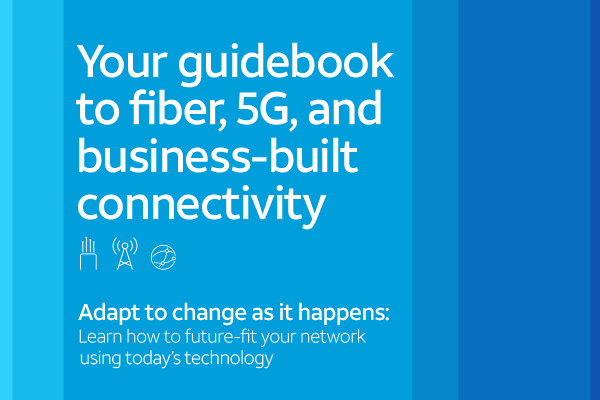Benefits of the new standards for network reliability
Every business relies on network connectivity: It powers employee and customer communication and interactions, enables businesses to run applications on the cloud, and makes it possible for modern machines to operate efficiently. Connectivity is the foundation and the highway for a business to operate. Many businesses still struggle with determining what to look for in quality network connectivity beyond just “needing it to work.”
Over the past several years, we’ve seen a shift in how business leaders think about their network management. They’re prioritizing network modernization—migrating from aging legacy lines, which include copper. Not only are the maintenance and repair costs of legacy infrastructure increasing, these lines also aren’t as reliable. They are more easily disrupted by natural events such as weather, aren’t as secure from cyberthreats, and cannot adequately support the data intensity of new and emerging technologies. As a result, delaying migration to a fiber network is no longer an option.
The technology market continues to evolve faster than ever before with innovations that help solve some of the biggest business challenges—productivity, efficiency, cybersecurity, hybrid work, workforce shortages, supply chain inefficiencies, sustainability, and more. With this evolution comes data. Lots of it. Data creation, data traffic, data analysis, data storage—and it all relies on one thing: your network.
This new business paradigm requires a network that is not just modernized but able to adapt to the avalanche of data now and into the future.
Increasing data demands require a new standard for networking
Analysts have been saying for years that it’s important to pay attention to the explosion of new technologies. Additionally, businesses that are forward-looking and leverage data-predictive tools are in a better position to take advantage of these tech trends. These demonstrate the proliferation and rapid expansion of data:
Internet of Things. We first heard the term “The Internet of Things” (IoT) in 1999. As of 2023, the global enterprise IoT market grew to $574.2 billion, and it is a big driver for how IT leaders have prioritized connectivity.
- The enterprise IoT market is expected to grow to $1,416.8 billion by 2030.1
Cloud. Cloud connectivity through a fiber network is needed to connect cloud servers to cloud data centers. The growth of cloud has been astronomical. In 2009, data center hardware and software spending was at $60.7 billion without cloud. As of 2023, spending has shifted from a data center model to cloud infrastructure services totaling $270 billion.2 Add to that, by 2025, a 61% increase of data, 175 zettabytes, are expected to be stored in the cloud.3
- In practical terms, a zettabyte is approximately 175 terabytes. One terabyte is approximately 200,000 5-minute songs. So, a zettabyte is a whopping 35 million 5-minute songs or the equivalent of 2.9 million hours of music.
5G. The 5G enterprise market continues to expand as businesses establish a greater dependency on the technology. 5G is essential for the ever-increasing dependency on mobility. As data moves from customized, business-specific applications and devices to 5G towers and into the fiber network, the entire ecosystem must be fast, reliable, efficient, and secure.
- By the end of 2023, the 5G market reached $4.1billion and is expected to grow to $45.5 billion by the end of 2032.4
Artificial Intelligence. Artificial Intelligence (AI) touches more business operations than most people realize. From subtle applications (chatbots) to daily operations (finances and cash flow analysis) and complex uses (robotics and production-related operations), AI is widely becoming one of the top technologies being developed and implemented across industries. Especially when combined with 5G and IoT, AI is helping to reshape the very essence of how companies operate.
- The current value of the AI market is approximately $184 billion. By 2030, it’s expected to grow across industries to nearly $826 billion.5
Add to all of this, the number of enterprise applications used by businesses continues to grow. The highest among these are security, engineering, and information technology (IT) with more than 60 applications each.6 These trends translate to the need for a new standard for networking to transmit the astronomical volumes of data being created and accessed through the network.
The new definition of network reliability
We’ve touched on IoT, cloud, 5G, AI, and enterprise applications, but the many ways that data is produced by businesses across industries is virtually endless. The result is very straightforward: The definition of network reliability has changed.
Then there’s the need to prioritize the customer experience—that goes for business-to-business customers and end users of the products and services they offer. The demand for easier access and a quality experience has also resulted in a market where loyalty is much harder to come by and retain.
A poor eCommerce experience? Not able to reach a business when they’re needed most? Products being out of stock? The customer’s expectations were not met? The list goes on. Building the customer experience from below the ground and up with fiber internet is the first step to mitigating these challenges. The new standard for fiber internet redefines reliability and security. It’s vital to building customer confidence and as a result, loyalty.
Understanding the importance of network reliability in business
Let’s take a closer look at why network reliability is so important to business operations and the customer experience. The fiber network enables many data-intensive technologies to operate. It also allows for the speed, efficiency, and security these technologies need to be effective.
There are three important factors that make a network reliable to deliver service quality. As a result, your business can adopt the technologies that are right for your unique business needs and have confidence your network has the power to support them.
Network intelligence. There are several layers to network intelligence. It includes connectivity—within the network itself, to 5G and business Wi-Fi, and all elements that rely on the network—security, and cloud connectivity. This intelligence routes traffic efficiently, effectively, and with agility. In other words, the network and the data traffic itself have the ability to grow, expand, and evolve to meet the associated demands. This happens through intelligent traffic routing.
- Network Intelligence Forecasting—a methodology that analyzes the performance of devices connected across the network—uses artificial intelligence and machine learning (ML) to gauge bandwidth. This enables the network to be agile in how it directs traffic to deliver better performance to users.
Network resilience. Legacy networks, which include old copper phone lines, are vulnerable to the elements. We’ve all experienced connectivity being interrupted during bad weather. Sometimes it becomes more than just a nuisance because we may have to restart or reboot systems and applications that can’t recover when connectivity is restored. This can be very costly to a business in time, productivity, and customer relationships.
- Fiber-optic cables have changed the game by improving connectivity to reduce outages. Fiber transmits data through light and, as a result, has a much larger bandwidth. It’s also far more resilient to bad weather and can withstand harsh elements. Plus, fiber is more secure because it can’t be manually hacked.
Network convergence. All of your traffic types—various types of data, voice, video, images—on a single network is network convergence. While most talk about 5G and fiber separately, we have an integrated approach that helps give customers the connectivity they need wherever and however they need to use it.
This includes mobility, Wi-Fi, and Ethernet and enables unprecedented efficiency for these signals. Network convergence contributes to reliability, because it provides another layer of redundancy. A wireline router with a built-in SIM that serves as a backup wouldn’t be there without a converged network.
- The future converged network offerings will be even more simplified. For example, rather than having to choose between wireless and wireline, you’ll be able to use the two technologies anywhere with the same features.
Together, these three factors are essential to service quality in business operations, which is the foundation for a quality customer experience.

The future of networking
Rick Welday, EVP-Enterprise Markets at AT&T Business shares the how we’re bringing new standard of networking to our customers.
How to improve network reliability
How do you move your business toward network reliability? There are a few steps you can take:
Consult with your IT team. Where are the challenges in your network? Are there internal traffic issues that have been put on the back burner? Sometimes the simplest challenges can be indicators of larger network issues.
- Have your IT team deliver a thorough network, security, and operations assessment to help you identify challenges and network priorities.
Get external consulting advice. Get an objective, third-party assessment with the AT&T Business Consulting and Professional Services team. Our experts are dedicated to serving businesses. They have the experience from extensive customer relationships to provide you with guidance and advice so you can make smart decisions about your network.
- Our network consulting experts will assess your internal evaluation and help you determine where to prioritize your network needs.
Create a roadmap. Having the right network and technology at your fingertips is a powerful tool. Working with the internal and external experts of your business enables you to plan how to use the tech today and what you’d like to adopt in the future.
- It can seem overwhelming to choose which technologies are best for your business. As exciting as this can be, it’s important to create a roadmap that includes what to adopt and when and if the tech is needed in only parts of your business or throughout.
Our mission in network reliability
It’s clear why the network is vital to the heart of business. It’s also why all of us here at AT&T Business are committed to raising the bar on what a network can do for our customers. Ultimately, a secure, reliable network is the foundation for a quality customer experience. We’re in a constant cycle of innovation focused on our network, inspired by the conversations we continually have with our customers and understanding what’s most important to them.
Our customers enjoy reliability on fiber and 5G that helps them keep their businesses moving forward. Through every point of the network journey, our next-generation technology enables them to be agile, flexible, and future-forward so they can learn from data, analyze, and make smarter business decisions.
How we’re delivering network reliability
Reliability is at the heart of our continued network transformation journey. For example, we software defined our network so that it is more agile and can easily scale to meet customer demands. We’ll gradually enable Standalone 5G for more customers to improve their connectivity experience with faster speeds and lower latency. We deployed 11 (eleven) 5G edge zones across the U.S. that can be used for technologies like autonomous cars, smart cities, or immersive experiences that require low latency to process massive amounts of data.
Intelligence and security are built in from the start rather than as an afterthought. Using artificial intelligence and machine learning, we can forecast network traffic and capacity. In addition, we plan infrastructure build sites, relocation of existing equipment, and even maintenance schedules. We detect and resolve anomalies and reduce energy consumption with ML-optimized cell site sleeping. We also eliminate robocalls, prevent fraudulent activity, and block traffic flooding distributed denial-of-service (DDoS) attacks so your internet is consistent and fast.
Our self-organizing network (SON) technologies adapt during heavy network traffic situations, allowing users to attach to other radios when one radio is congested. We can remotely adjust neighboring cell sites to accommodate customers if a tower goes down. All of this is designed to keep you connected and minimize the impact should there be an outage.
Supporting disaster recovery, first responders, and climate change
Our care for our customers extends into the communities where they live and operate. Just as the network is the foundation for their businesses, their communities and families are the foundation for why they work every day. There are many ways that we support our communities, and our network reliability contributes in three key ways:
Disaster recovery. Perhaps nowhere is network reliability and resilience more important than in emergencies and natural disasters. One of our goals is to help businesses better handle what they can—and recover from what they cannot—control.
With more than $1.1 billion invested in the U.S., our Network Disaster Recovery (NDR) program is one of the largest, and most advanced of its kind in the world. Its sole purpose is to rapidly restore connectivity to areas affected by disasters. And our efforts to combat extreme weather and climate events, as well as increase instabilities in the commercial power infrastructure landscape, have helped us reduce the likelihood of major mobility network outages by nearly 35%.
FirstNet®. Together, in a public-private partnership with the First Responder Network Authority, we’re proud to deliver FirstNet®, the nation’s only network built with and for first responders. Highly secure, reliable connectivity is critical to public safety’s life-saving missions. It’s why FirstNet was designed based on years of consultation with public safety. When called upon to handle emergencies, FirstNet provides public safety with the best tools to help them respond safely, efficiently, and effectively.7
For example, public safety agencies have access to a FirstNet fleet of 150+ dedicated land-based and airborne portable network assets at no additional charge. In addition, they have access to over 400 assets in the AT&T Network Disaster Recovery Fleet when needed and available. And as the only carrier that can provide end-to-end emergency communication solutions to support 9-1-1 dispatchers, first responders in the field, telecommunicators, and emergency personnel from the moment the incident is introduced until their mission is complete, we’ll continue to deliver reliable, highly secure, dedicated capacity and coverage to first responders when they need it.
Climate change. AT&T has been working with the U.S. Department of Energy’s Argonne National Labs to identify the potential impacts of climate change on network infrastructure and our operations—up to 30 years into the future. Our Climate Change Analysis Tool (CCAT) studies climate impacts, such as flooding, hurricanes, drought, and wildfires, and helps us boost climate resilience for our company and the communities we serve.
The climate models and rich datasets produced from this project are available to the public so that municipalities, universities, and other companies can benefit from using them as part of their long-range sustainability and resilience plans.
Learn more about AT&T Business networking services or contact your AT&T Business representative to connect with experts who know business.
Why AT&T Business?
See how ultra-fast, reliable fiber and 5G connectivity protected by built-in security give you a new level of confidence in the possibilities of your network. Let our experts work with you to solve your challenges and accelerate outcomes. Your business deserves the AT&T Business difference—a new standard for networking.
- “Enterprise IoT Market Size, Share & Trends Analysis Report by Component (Hardware, Software & Solutions, And Services), By Enterprise Type, By End-use, By Region, And Segment Forecasts, 2022 – 2030,” Grand View Research, Accessed May 19, 2023, https://www.grandviewresearch.com/industry-analysis/enterprise-iot-market-report.
- “Enterprise spending on cloud and data centers by segment 2009-2022,” Statista, Accessed May 22, 2023, https://www.statista.com/statistics/1114926/enterprise-spending-cloud-and-data-centers/.
- Jack Flynn, “25 Amazing cloud adoption statistics [2023]: cloud migration, computing, and more,” Zippa, December 19, 2022, https://www.zippia.com/advice/cloud-adoption-statistics.
- “5G Enterprise Market: Global Industry Trends, Share, Size, Growth, Opportunity, and Forecast 2023-2028,” Imarc Group, Accessed May 22, 2023, https://www.imarcgroup.com/5g-enterprise-market.
- “Artificial intelligence (AI) market size worldwide in 2021 with a forecast until 2030,” Statista, Accessed May 22, 2023, https://www.statista.com/statistics/1365145/artificial-intelligence-market-size.
- Roberto Torres, “Enterprise app sprawl swells, with most apps outside of IT control,” CIO Dive, September 20, 2021, https://www.ciodive.com/news/app-sprawl-saas-data-shadow-it-productiv/606872/.
- FirstNet and the FirstNet logo are registered trademarks of the First Responder Network Authority. All other marks are the property of their respective owners.



